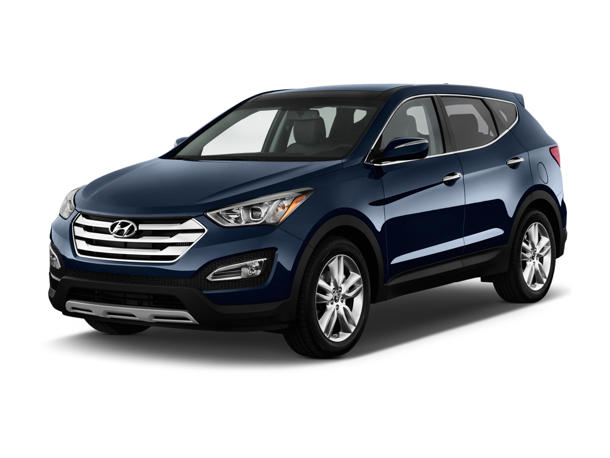

Executive wheels: Hyundai’s swing and a hit
Jeff Rundles //July 29, 2013//

2013 HYUNDAI SANTA FE SPORT FWD 2.4
Like most everyone else, I was somewhat excited and skeptical when Hyundai first came to the United States market in February 1986 with just one vehicle, the Hyundai Excel. We hadn’t seen a Korean automaker on these shores, and its opening salvo ad campaign comparing itself favorably with Honda, but at a lower price, seemed like a good idea. After all, Honda and Toyota where setting the standard for quality and innovation, and it seemed like another Asian manufacturer would know what they were up against and come out swinging.
They whiffed. The first Hyundai sold well, but soon quality problems got so bad that the company was subjected to humor and ridicule. It took several years, but Hyundai officials got the quality/competitive message and began making great, high-quality cars.
This opening fiasco, however, ended up benefitting consumers: Hyundai, saddled with a poor reputation, was forced to make top-quality cars, hold prices down and offer the best warranties in the business – and to this day those benefits remain.
For instance, the 2013 Santa Fe carries a 5-year/60k full warranty, a 10-year/100k powertrain warranty, a 7-year/unlimited mile anti-perforation warranty, and 5-year/unlimited miles roadside assistance. The interesting thing is that the newer Hyundais (for years actually) are so good, you probably won’t ever exercise any of these warranties.
I drove the 2013 Hyundai Santa Fe Sport 2.4 during a 10-day trip to Michigan. The three of us had plenty of luggage and golf bags, and we drove all over the state. I’ve done this many times in many vehicles, but I was glad this time to have the Santa Fe. It’s very versatile, very comfortable – and it drives like a dream.
I haven’t driven a Santa Fe in years, but I have talked about it since – and recommended it many times to prospective car buyers – because I was completely taken with it back then. The right size, the right power, great responsiveness, great gas mileage – it had everything.
I was a bit nervous this time around because its 2.4-liter I4 engine, putting out some 190 hp, sounded underpowered for an SUV. But it felt like it had a 3.5-liter V6 – it cruised at speed with ease, accelerated with responsiveness and was incredibly quiet. Even in cruise control, there was no huffing and puffing to maintain speed.
The mileage rating on this 6-speed auto transmission package is 21 mpg city/29/mpg highway – and that’s pretty much what we experienced. You have to love a vehicle that gets that kind of mileage but acts like a much more potent, and thirsty, ride.
The Santa Fe in 2013 is a mid-sized SUV/crossover, placed in the car’s line between the smaller Tucson and the larger Vera Cruz. For 2014, the company plans to eliminate the Vera Cruz and make a Santa Fe with a longer wheelbase, with seating up to eight, to take the larger SUV space. (For 2013 the Sport edition, about half of the 8 trims available, is a 5-passenger vehicle, while the GLS and the Limited (both equipped with a 3.3-liter V6 with 290 hp rated at 18/24 in AWD) can carry up to seven passengers.
This is a very handsome vehicle, and I expected it to cost much more. The standard equipment on this vehicle is impressive – most all of the luxury items included (like Sirius satellite radio with all the modern techno inputs) – for a base price of $24,450 ($26,450 in AWD).
Ours included upgraded power seats up front, leather upholstery, heated rear seats, a larger color display screen (4.3 inches), rearview camera, panoramic sunroof, navigation and various other things. The packages added another $6,000 (a pretty good rate for extras). With an $875 destination charge, the bottom sticker line was $32,175, which seemed amazing compared with its competition.
 While the performance and handling of the Santa Fe impressed me as much as any vehicle of this type I have driven in years, what I found most appealing was the interior. The seats were very comfortable, especially suited for a long road trip.
While the performance and handling of the Santa Fe impressed me as much as any vehicle of this type I have driven in years, what I found most appealing was the interior. The seats were very comfortable, especially suited for a long road trip.
The second-row bench seat was also great, featuring a 40/20/40 split configuration, easily accessed from the rear, so you could have the rear seat be a single seat with more storage, or a double seat from either side. We elected the 40/20 split so that our golf bags were lengthwise and our other luggage – three suitcases and a couple of backpacks – were in the rear area, and with all that I still had a full view out of the rearview mirror. In other words, this is a very cargo-friendly, versatile vehicle.
The Santa Fe’s nimble handling and perfect size made driving around town and parking a pleasure. Many crossovers/SUVs are great on the road but problematic in the city. The Santa Fe Sport is built on the Hyundai Elantra passenger car platform, so it rides more like a car than a truck. Getting in and out or into the ample cargo space is very easy, unlike many trucks and truck-like vehicles.
The Santa Fe had no issues. I loved the vehicle. And with the price, given all you get – and trust me, I have driven many similar Japanese, European and U.S. vehicles – the Santa Fe represents one of the better deals in the marketplace.
Hyundai swung and missed on the first pitch nearly 30 years ago. But once they got it together, the line – and this Santa Fe Sport – are solid hits.
RATING: 4 WHEELS AND THE SPARE (OUT OF FOUR)






















